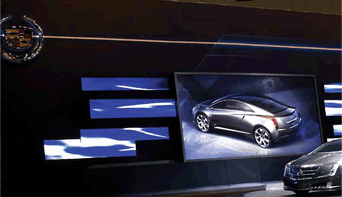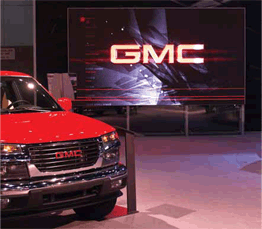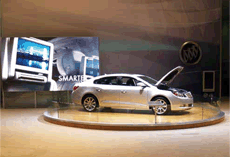BlueWater’s Customized Displays Electrify General Motors’ Exhibit
For the new Chevy Volt exhibit, BlueWater used 225 Barco MiTrix LED tiles to create media-integrated multiple vertical panels that stepped down to horizontal, forming a platform for the Volt chassis.
On the auto show circuit, traditionally bigger is better, and the more spectacular an exhibit, the more successful. In 2009, a year plagued by recession and re-organization, automakers were scaling back on the glitz and glamour of auto shows and refocusing the spotlight onto the latest vehicles to hit the road.
As a tier-one provider for General Motors, company executives commissioned BlueWater Technologies to engineer the GM technical footprint at the 2009 Los Angeles Auto Show. Their goal was to bring an impressive technology-driven exhibit that would garner attention to all the automaker’s brands, while highlighting the Cadillac Converj concept car and the new Chevrolet Volt — the centerpieces of GM’s 2009 exhibit.
After months of planning and reviewing the most advanced technology on the market, BlueWater, in collaboration with General Motors, integrated the technology into the GM space. BlueWater technicians integrated multiple 16- x 9-foot Barco I6 XP LED walls with Barco DX700 processing into the Chevrolet, Buick, and GMC brands. An integrated Watchout computer playback system, with networked Medialon Show Control, allowed all video to be sourced back from one master control location. Wireless narration microphones for product specialists were provided through network-controlled Shure UHF-R systems. More than 70 speakers on the show floor were sourced by a Yamaha PM5DRH digital mixer, providing crystal-clear audio. This technology and audio design could be remotely controlled from any location in the GM space via a wireless networked tablet PC. Every exhibit was outfitted with CRM electronic data capture equipment and desktop computers that provided access to the GM family of websites.

In the Cadillac Converj concept exhibit, BlueWater engineers used the latest Barco technologies — a 16- x 9-foot NX4 Barco LED Wall served as the main screen and 100 Barco NX4 LED tiles.
In the Cadillac Converj concept exhibit, GM executives wanted to create an air of excitement in order to ref lect the luxury Cadillac is known for, as well as the Converj’s bold design and advanced technology. BlueWater engineers used the latest Barco technologies — a 16- x 9-foot NX4 Barco LED wall served as the main screen and 100 Barco NX4 LED tiles, which were separated into modules for custom configuration — to create an eye-catching wing effect reflecting the vehicle’s power. The use of NX modules in creative mode for this exhibit was the first ever for the North American market.
For the Volt exhibit, an extended range electric vehicle, BlueWater was asked to customize a

BlueWater technicians integrated multiple 16- x 9-foot Barco I6 XP LED walls with Barco DX700 processing into the and GMC brand. display that had an aura of electricity and to communicate an environmental friendly message. To accomplish that, BlueWater used 225 Barco MiTrix LED tiles to create mediaintegrated multiple vertical panels that stepped down to horizontal, forming a platform for the Volt chassis. A 16- x 9-foot Barco NX4 LED wall was layered with creative Plexiglas for the maximum visual impact. Interactive touchscreen kiosks that provided information on both the vehicle and its innovative technologies supported the video message. Through the use of an integrated computer playback system, controlled via Apple iTouch, product specialists were able to isolate a kiosk and showcase vehicle information on the main display as well.
The General Motors exhibit at the Los Angeles Auto Show drew hundreds of thousands of prospective customers and the attention of more than 6000 international media outlets. At a time when automakers are re-positioning for the future, the use of advanced technology allowed General Motors to reinforce their focus on leaner, greener vehicles and drive home their dedication to re-invention.
